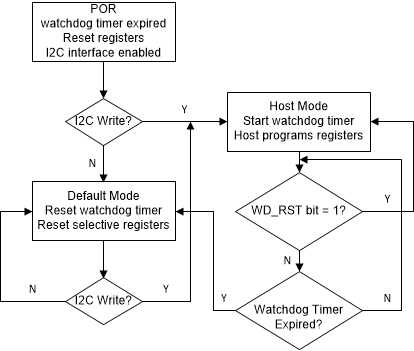JAJSJS8B October 2020 – July 2024 BQ25618E , BQ25619E
PRODUCTION DATA
- 1
- 1 特長
- 2 アプリケーション
- 3 概要
- 4 概要 (続き)
- 5 Device Comparison Table
- 6 Pin Configuration and Functions
- 7 Specifications
-
8 Detailed Description
- 8.1 Overview
- 8.2 Functional Block Diagram
- 8.3
Feature Description
- 8.3.1 Power-On-Reset (POR)
- 8.3.2 Device Power Up From Battery Without Input Source
- 8.3.3 Power Up From Input Source
- 8.3.4 Power Path Management
- 8.3.5 Battery Charging Management
- 8.3.6 Ship Mode and QON Pin
- 8.3.7 Status Outputs ( STAT, INT , PG )
- 8.3.8 Protections
- 8.3.9 Serial Interface
- 8.4 Device Functional Modes
- 8.5 Register Maps
- 9 Application and Implementation
- 10Power Supply Recommendations
- 11Layout
- 12Device and Documentation Support
- 13Revision History
- 14Mechanical, Packaging, and Orderable Information
8.4.1 Host Mode and Default Mode
The device is a host controlled charger, but it can operate in Default Mode without host management. In Default Mode, the device can be used an autonomous charger with no host or while host is in Sleep Mode. When the charger is in Default Mode, WATCHDOG_FAULT bit is HIGH. When the charger is in Host Mode, WATCHDOG_FAULT bit is LOW.
After power-on-reset, the device starts in Default Mode with watchdog timer expired, or Default Mode. All the registers are in the default settings.
In Default Mode, the device keeps charging the battery with 10-hour fast charging safety timer. At the end of the 10-hour, the charging is stopped and the buck converter continues to operate to supply system load. Any write command to device transitions the charger from Default Mode to Host Mode. All the device parameters can be programmed by the host. To keep the device in Host Mode, the host has to reset the watchdog timer by writing 1 to WD_RST bit before the watchdog timer expires (WATCHDOG_FAULT bit is set), or disable watchdog timer by setting WATCHDOG bits = 00.
All the device parameters can be programmed by the host. To keep the device in Host Mode, the host has to reset the watchdog timer by writing 1 to WD_RST bit before the watchdog timer expires (WATCHDOG_FAULT bit is set), or disable watchdog timer by setting WATCHDOG bits = 00.
 Figure 8-14 Watchdog
Timer Flow Chart
Figure 8-14 Watchdog
Timer Flow Chart